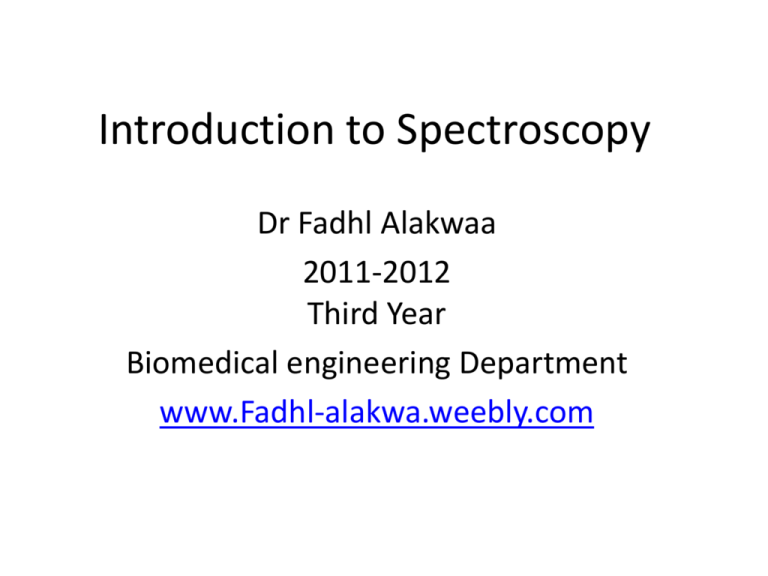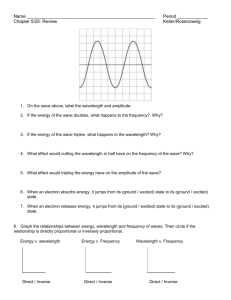Introduction to Spectroscopy - Fadhl Alakwaa, PhD
advertisement

Introduction to Spectroscopy
Dr Fadhl Alakwaa
2011-2012
Third Year
Biomedical engineering Department
www.Fadhl-alakwa.weebly.com
Introduction to Spectroscopy
• Spectroscopy is the science
which study the interaction
of radiation with matter.
• the study of molecular
structure and dynamics
through the absorption,
emission, and scattering of
light.
What is Electromagnetic Radiation?
• Visible light that comes from your lamb and
radio waves from your radio station.
• Example: Radio waves, Microwaves, IR,
Visible, UV, X-ray, Gamma ray.
What is Electromagnetic Radiation?
E = hn
n=c/l
X-Ray
UV
200nm
Visible
400nm
IR
800nm
WAVELENGTH(nm)
Microwave
100,000nm
The Nature
of Light
Electromagnetic
radiation is
viewed as both a wave
and a particle
wave-particle duality
Understanding the nature of light
1. Light is composed of particles
2. Light is wave
a. General concepts of Wave
(wavelength, frequency, velocity, amplitude)
b. Properties of Wave
I. Diffraction & Coherent Radiation
II. Transmission & Dispersion
III. Refraction: Snell’s Law
3. Black Body Radiation and photoelectric effect
wave-particle duality
4. Interaction between electromagnetic radiation
and matter for spectroscopy: scattering, absorption,
and emission
Light travels in a straight line
Light is consists of small particles
Newton
The Thomas Young’s Experiment (1801)
Interference phenomenon: Light is wave!
Light is Electromagnetic Wave
Maxwell
(1864)
What is a wave?!
amplitude
Harmonic
wave:
wavelength
frequency
or
wavelength
velocity
=
wavelength
l Wavelength
(meters)
c
Frequency
frequency
n=
(Hertz)
Velocity (300,000,000 meters/sec)
Propagation
Wave Parameters
The amplitude A of the sinusoidal wave is shown as the
length of the electric vector at a maximum in the wave.
The time in seconds required for the passage of successive
maxima or minima through a fixed point in space is called the
period, p, of the radiation.
The frequency, n, is the number of oscillations of the field
that occur per second and is equal to l/p.
Another parameter of interest is the wavelength, l, which
is the linear distance between any two equivalent points on
successive waves (e.g., successive maxima or minima).
angstrom:
10 -10 m nanometer: 10 -9 m
micrometer: 10 -6 m millimeter: 10 -3 m
Equation of wave motion
• Y =a sin(wt-kx+Θ)
• Displacement due to wave at any distance x
and time t
• a maximum displacement
• W=2pi*f (angular velocity)
• k =2 pi /wavelength (propagation constant)
• Θ phase angle
Equation of wave motion
• Mechanical wave
• Sound wave
• Electromagnetic wave
Electromagnetic Energy
• Light is composed of particles ”Photons”
• E =hf =hc/λ h= 6.626x10^-34 j.s (Plank
constant)
• Photon energy unit is (e.v)
• Energy gained by one electron when
accelearted by potential difference of one volt
• e.v=1.6x10^-19 coulomb x 1 volt= =1.6x10^19 Joule
Matter
• Component >> atom like Iron {FE}
• Compound >> Molecular like Sugar {CHO}
{more than one atom}
•
Atom
Proton
Mass number
A=# protons + Neutrons
X
Z = # electrons
Atomic Number
Periodic table
Neutron
Electron
Uranium
238
U
92
Isotopes the same Z and different A
1
Hydrogen
H
1
2
H
1
3
H
1
Deuterium
Tritium
One proton
One proton
One neutron
One proton
Two neutrons
When Light Strikes Matter…
Transmission
Absorption
Reflection
Refraction
Interference
Scattering
Excitation methods:
•
•
•
•
(i) EM radiation
(ii) Spark/discharge/arc
(iii) Particle bombardment (electrons, ions... )
(iv) Chemiluminescence (exothermic chemical
reaction generates excited products
Absorption Spectra
Absorption
Spectra Plot of
Absorbance vs.
wavelength
called
absorption
spectrum.
Emission Spectra
Emission
Spectra Plot of
emission
intensity vs.
wavelength
called
emission
spectrum.
Question page 33 Example 2
• Given that the ionization potential of
hydrogen atom is 13.6 volt and the energy
level of any………..
• Home work 1 ,2, 3 pages 39 and 40







